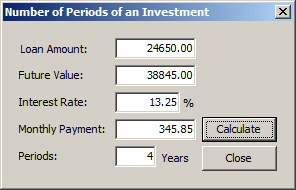 |
Math Functions: The Number of Periods of an
Investment |
|
|
|
The NumberOfPeriods() function calculates the
number of periodic payments of an investment. Here is an example of
calling this function:
|
//---------------------------------------------------------------------------
#include <vcl.h>
#include <math.hpp>
#pragma hdrstop
#include "Exercise.h"
//---------------------------------------------------------------------------
#pragma package(smart_init)
#pragma resource "*.dfm"
TForm1 *Form1;
//---------------------------------------------------------------------------
__fastcall TForm1::TForm1(TComponent* Owner)
: TForm(Owner)
{
}
//---------------------------------------------------------------------------
void __fastcall TForm1::btnCalculateClick(TObject *Sender)
{
Extended Present, Future, Rate, Payments, NPeriod;
Present = StrToFloat(edtPresentValue->Text);
Future = StrToFloat(edtFutureValue->Text);
Payments = StrToFloat(edtMonthlyPayment->Text);
Rate = StrToFloat(edtInterestRate->Text);
// Apply the function
NPeriod = NumberOfPeriods(Rate / 100, -Payments, -Present,
Future, ptStartOfPeriod);
// Since the number of periods is really an integer, find its ceiling
Extended Actual = Ceil(NPeriod);
// Display the number of periods
edtPeriods->Text = FloatToStr(Actual);
}
//---------------------------------------------------------------------------
void __fastcall TForm1::btnCloseClick(TObject *Sender)
{
PostQuitMessage(0);
}
//---------------------------------------------------------------------------

|
|